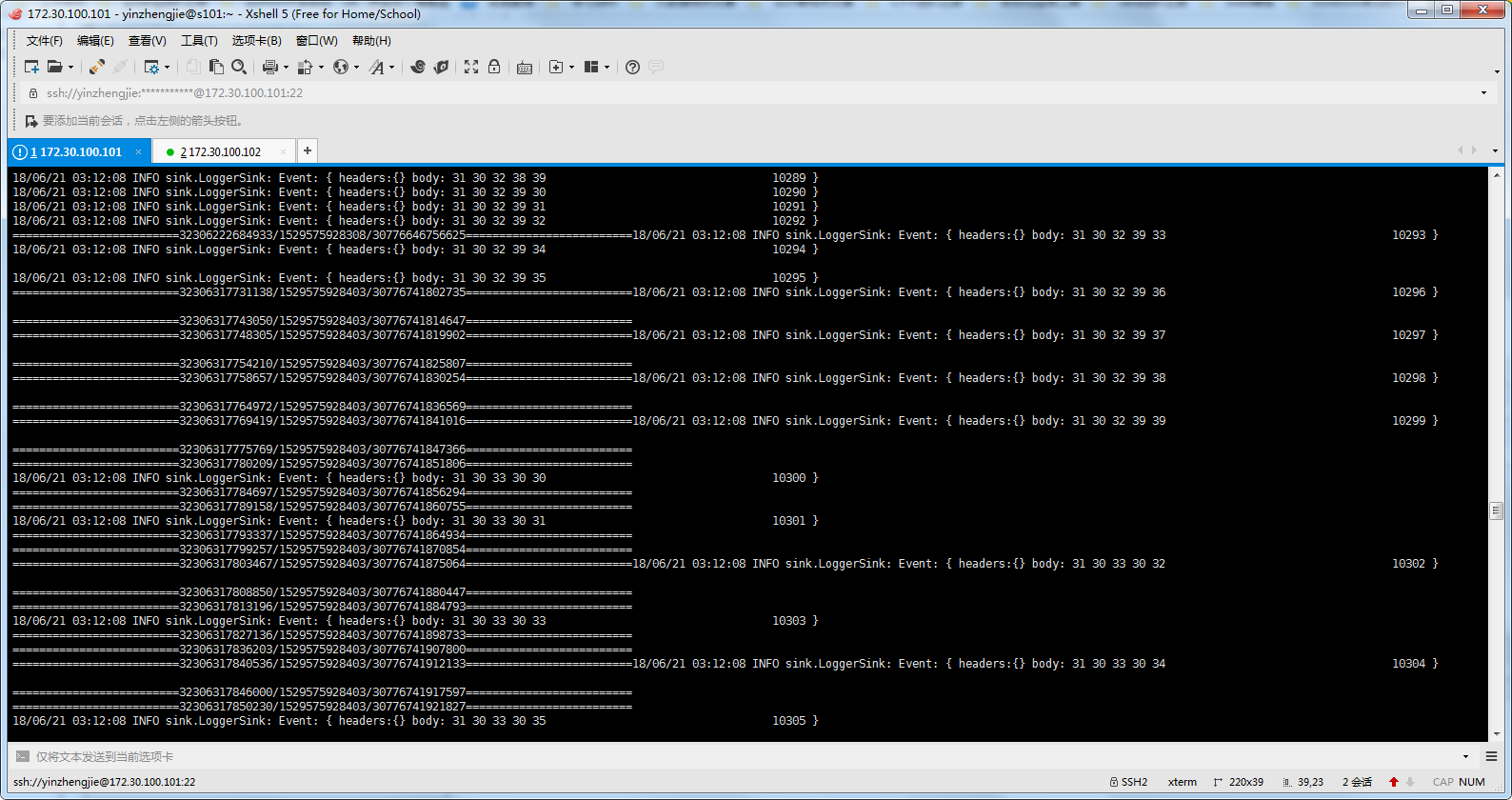Hadoop生态圈-Flume的组件之自定义拦截器(interceptor)
Hadoop生态圈-Flume的组件之自定义拦截器(interceptor)
作者:尹正杰
版权声明:原创作品,谢绝转载!否则将追究法律责任。
本篇博客只是举例了一个自定义拦截器的方法,测试字节传输速度。
1>.自定义interceptor方法
/*
@author :yinzhengjie
Blog:http://www.cnblogs.com/yinzhengjie/tag/Hadoop%E7%94%9F%E6%80%81%E5%9C%88/
EMAIL:y1053419035@qq.com
*/
package cn.org.yinzhengjie.interceptor; import org.apache.flume.Context;
import org.apache.flume.Event;
import org.apache.flume.interceptor.Interceptor; import java.util.List; /**
* 设置限速拦截器
* <p>
* 当 字节/时间,即同一时刻,如果进入的字节过多
* 则休眠一会
*/
public class MyInterceptor implements Interceptor { private int speed; //构造
private MyInterceptor(int speed) {
this.speed = speed;
} //do nothing
public void initialize() { } /**
* 1、拿出上一个event的时间,和当前时间进行相减,得出上一个event的时间间隔
* 2、得到上一个event的body字节数
* 3、相除得到上一个event的速度,并在此event中先进行停留,再返回event
*
* @param event
* @return
*/ long lastTime = -1;
long lastBodySize = 0; public Event intercept(Event event) { byte[] body = event.getBody();
int len = body.length; long current = System.nanoTime(); //第一个event
if (lastTime == -1) {
lastTime = current;
lastBodySize = len;
} //非第一个event
else {
//计算上一个event停留的时间
long interval = current - lastTime;
System.out.println("=========================" + current + "/" + lastTime + "/" + interval + "=========================");
//上一个event的速度
int now_speed = (int) ((double) lastBodySize / interval * 1000);
if (now_speed > speed) {
System.out.println("=========================" + now_speed + "=========================");
//计算需要停留多少秒 线程休眠,时间 = shouldTime - interval
try {
Thread.sleep((lastBodySize / speed) * 1000 - interval);
} catch (InterruptedException e) {
e.printStackTrace();
}
}
lastBodySize = len;
lastTime = System.currentTimeMillis(); }
return event; } //迭代List<Event>,将所有Event交给intercept(Event)进行处理
public List<Event> intercept(List<Event> events) {
for (Event event : events) {
intercept(event);
}
return events;
} //do nothing
public void close() { } public static class Builder implements Interceptor.Builder { private int speed; public void configure(Context context) {
speed = context.getInteger(Constants.SPEED, Constants.DEFAULT_SPEED); } public Interceptor build() {
return new MyInterceptor(speed);
}
} public static class Constants {
public static String SPEED = "speed";
public static int DEFAULT_SPEED = 1; }
}
2>.打包并将其发送到 /soft/flume/lib下
[yinzhengjie@s101 ~]$ cd /soft/flume/lib/
[yinzhengjie@s101 lib]$
[yinzhengjie@s101 lib]$ ll | grep MyFlume
-rw-r--r-- 1 yinzhengjie yinzhengjie 5231 Jun 20 18:53 MyFlume-1.0-SNAPSHOT.jar
[yinzhengjie@s101 lib]$
[yinzhengjie@s101 lib]$ rm -rf MyFlume-1.0-SNAPSHOT.jar
[yinzhengjie@s101 lib]$
[yinzhengjie@s101 lib]$ rz [yinzhengjie@s101 lib]$
[yinzhengjie@s101 lib]$ ll | grep MyFlume
-rw-r--r-- 1 yinzhengjie yinzhengjie 8667 Jun 20 21:02 MyFlume-1.0-SNAPSHOT.jar
[yinzhengjie@s101 lib]$
[yinzhengjie@s101 lib]$
3>.编写agent的配置文件
[yinzhengjie@s101 ~]$ more /soft/flume/conf/yinzhengjie_myInterceptor.conf
# Name the components on this agent
a1.sources = r1
a1.sinks = k1
a1.channels = c1 # 定义源: seq
a1.sources.r1.type = seq
# 定义一次RPC产生的批次数量
a1.sources.r1.batchSize = # 指定添加拦截器
a1.sources.r1.interceptors = i1
a1.sources.r1.interceptors.i1.type = cn.org.yinzhengjie.interceptor.MyInterceptor$Builder
a1.sources.r1.interceptors.i1.speed = # Describe the sink
a1.sinks.k1.type = logger # Use a channel which buffers events in memory
a1.channels.c1.type = memory
a1.channels.c1.capacity =
a1.channels.c1.transactionCapacity = # Bind the source and sink to the channel
a1.sources.r1.channels = c1
a1.sinks.k1.channel = c1
[yinzhengjie@s101 ~]$
4>.启动flume并测试
[yinzhengjie@s101 ~]$ flume-ng agent -f /soft/flume/conf/yinzhengjie_myInterceptor.conf -n a1
下图是运行agent部分的输出内容

Hadoop生态圈-Flume的组件之自定义拦截器(interceptor)的更多相关文章
- Hadoop生态圈-Flume的组件之自定义Sink
Hadoop生态圈-Flume的组件之自定义Sink 作者:尹正杰 版权声明:原创作品,谢绝转载!否则将追究法律责任. 本篇博客主要介绍sink相关的API使用两个小案例,想要了解更多关于API的小技 ...
- Hadoop生态圈-Flume的组件之拦截器与选择器
Hadoop生态圈-Flume的组件之拦截器与选择器 作者:尹正杰 版权声明:原创作品,谢绝转载!否则将追究法律责任. 本篇博客只是配置的是Flume主流的Interceptors,想要了解更详细 ...
- Hadoop生态圈-Flume的组件之sink处理器
Hadoop生态圈-Flume的组件之sink处理器 作者:尹正杰 版权声明:原创作品,谢绝转载!否则将追究法律责任. 一. 二.
- Flume(二) —— 自定义拦截器、Source、Sink
自定义拦截器 自定义Source 自定义Sink 引入依赖 <dependency> <groupId>org.apache.flume</groupId> < ...
- Struts2自定义拦截器Interceptor以及拦截器登录实例
1.在Struts2自定义拦截器有三种方式: -->实现Interceptor接口 public class QLInterceptorAction implements Interceptor ...
- 第1节 flume:15、flume案例二,通过自定义拦截器实现数据的脱敏
1.7.flume案例二 案例需求: 在数据采集之后,通过flume的拦截器,实现不需要的数据过滤掉,并将指定的第一个字段进行加密,加密之后再往hdfs上面保存 原始数据与处理之后的数据对比 图一 ...
- Struts2自定义拦截器
1. 需求 自定义拦截器实现,用户登录的访问控制. 2. 定义拦截器类 public class LoginInterceptor extends AbstractInterceptor { @Ove ...
- struts2--实现自定义拦截器
前言: 本篇文章,我想说清实现拦截器的办法,还有为什么要这样做: 目录: 1.需求目的 2.实现步骤及原理(文字怕描述不清,画图描述) 3.代码 4.总结 一.需求目的 规范或限制越级访问(例如:一个 ...
- java:struts框架3(自定义拦截器,token令牌,文件上传和下载(单/多))
1.自定义拦截器: struts.xml: <?xml version="1.0" encoding="UTF-8"?> <!DOCTYPE ...
随机推荐
- python面试题(四)
一.数据类型 1.字典 1.1 现有字典 dict={‘a’:24,‘g’:52,‘i’:12,‘k’:33}请按字典中的 value 值进行排序? sorted(dict.items(),key=l ...
- Java开源博客My-Blog之docker容器组件化修改
前言 5月13号上线了自己的个人博客,<Docker+SpringBoot+Mybatis+thymeleaf的Java博客系统开源啦>,紧接着也在github上开源了博客的代码,到现在为 ...
- Dive查看docker镜像层信息
1.主要采用docker运行dive的方式,不然宿主机还要安装go那些挺麻烦的.具体用法可查看官方: https://github.com/wagoodman/dive 2.拉取dive镜像 dock ...
- Anibei前端基础学习
html.html5.CSS2.CSS3.JQuery.Vue.js学习,后端程序媛开始学习前端开发啦.
- opencv core组件进阶
1.图像在内存中存储方式,图像矩阵的大小取决于颜色模型,取决于所有的通道数:还有重要的颜色空间缩减的概念:因为如果是RGB的话,使用uchar的话,就有256^3的结合方法.所以要用到颜色缩减的方法, ...
- 【转载】kafka 基础知识
1. kafka介绍 1.1. 主要功能 根据官网的介绍,ApacheKafka®是一个分布式流媒体平台,它主要有3种功能: 1:It lets you publish and ...
- Jenkins邮件通知
Jenkins邮件通知 Jenkins 配备了一个开箱工具,添加一个电子邮件通知的构建项目. 第1步 - 配置SMTP服务器. 转到 Manage Jenkins → Configure System ...
- hive insert 动态分区异常(Error encountered near token)与解决
当insert数据到有分区的hive表里时若不明显指定分区会抛出异常 insert overwrite table persons_tmp select * from persons; FAILED: ...
- 关于使用实验室服务器的GPU以及跑上TensorFlow代码
连接服务器 Windows - XShell XFtp SSH 通过SSH来连接实验室的服务器 使用SSH连接已经不陌生了 github和OS课设都经常使用 目前使用 192.168.7.169 使用 ...
- 冒泡排序的C、C++实现
一.冒泡排序 冒泡排序就是重复地走访过要排序的元素列,依次比较两个相邻的元素,如果他们的顺序(如数字从大到小.首字母从A到Z)错误就把他们交换过来.走访元素的工作是重复地进行直到没有相邻元素需要交换, ...
